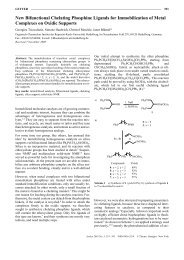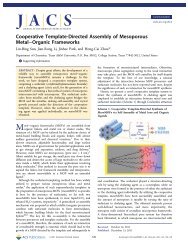Gold Nanoparticles - Department of Chemistry
Gold Nanoparticles - Department of Chemistry
Gold Nanoparticles - Department of Chemistry
Create successful ePaper yourself
Turn your PDF publications into a flip-book with our unique Google optimized e-Paper software.
PERSPECTIVE<br />
pubs.acs.org/NanoLett<br />
<strong>Gold</strong> <strong>Nanoparticles</strong>: A Revival in Precious Metal Administration to Patients<br />
A. S. Thakor, †,‡ J. Jokerst, † C. Zavaleta, † T. F. Massoud, †,‡ and S. S. Gambhir* ,†,§<br />
†<br />
Molecular Imaging Program at Stanford, <strong>Department</strong> <strong>of</strong> Radiology, Stanford University, California 94305-5427, United States<br />
‡<br />
<strong>Department</strong> <strong>of</strong> Radiology, University <strong>of</strong> Cambridge, Cambridge, CB2 2QQ, U.K.<br />
§<br />
<strong>Department</strong>s <strong>of</strong> Bioengineering & Materials Science and Engineering. Member Bio-X Program, Stanford University,<br />
California 94305-5427, United States<br />
ABSTRACT: <strong>Gold</strong> has been used as a therapeutic agent to treat a wide variety <strong>of</strong><br />
rheumatic diseases including psoriatic arthritis, juvenile arthritis, and discoid lupus<br />
erythematosus. Although the use <strong>of</strong> gold has been largely superseded by newer<br />
drugs, gold nanoparticles are being used effectively in laboratory based clinical<br />
diagnostic methods while concurrently showing great promise in vivo either as a<br />
diagnostic imaging agent or a therapeutic agent. For these reasons, gold nanoparticles<br />
are therefore well placed to enter mainstream clinical practice in the near<br />
future. Hence, the present review summarizes the chemistry, pharmacokinetics,<br />
biodistribution, metabolism, and toxicity <strong>of</strong> bulk gold in humans based on decades<br />
<strong>of</strong> clinical observation and experiments in which gold was used to treat patients with<br />
rheumatoid arthritis. The beneficial attributes <strong>of</strong> gold nanoparticles, such as their<br />
ease <strong>of</strong> synthesis, functionalization, and shape control are also highlighted demonstrating<br />
why gold nanoparticles are an attractive target for further development and optimization. The importance <strong>of</strong> controlling the<br />
size and shape <strong>of</strong> gold nanoparticles to minimize any potential toxic side effects is also discussed.<br />
KEYWORDS: <strong>Nanoparticles</strong>, gold, toxicity, humans, applications<br />
One <strong>of</strong> the most significant developments in recent years has<br />
been the development <strong>of</strong> new materials in the nanometer<br />
scale called nanoparticles. <strong>Nanoparticles</strong> are expected to form the<br />
basis <strong>of</strong> many <strong>of</strong> the technological and biological innovations <strong>of</strong><br />
this century, exhibiting distinct advantageous physical, chemical,<br />
and biological properties. They also have the potential to help<br />
establish specific beneficial processes and achieve selectivity<br />
within biological settings. To date, a large number <strong>of</strong> nanoparticles<br />
have been synthesized, especially those made from noble<br />
metals such as gold. <strong>Gold</strong> nanoparticles can be manufactured<br />
into a variety <strong>of</strong> shapes including gold nanospheres, nanorods,<br />
nanobelts, nanocages, nanoprisms, and nanostars. 1 The chemical,<br />
optical, and electromagnetic properties <strong>of</strong> gold nanoparticles<br />
are strongly influenced by their size and shape. For example, in<br />
comparison to metallic gold which is golden yellow, spherical<br />
gold nanoparticles have a visible red wine color while gold<br />
nanorods are blue (aspect ratio 2 3) or black (aspect ratio 3)<br />
in solution. 2 The ease <strong>of</strong> synthesis and the unique properties <strong>of</strong><br />
gold nanoparticles make them ideal candidates for translation<br />
from the laboratory setting into the clinical arena for use in<br />
humans. Additional enthusiasm for the use <strong>of</strong> gold nanoparticles<br />
in patients stems from gold’s previous clinical use in treating<br />
several diseases, most notably rheumatoid arthritis (RA), with<br />
minimal biological side effects. Although gold may have fallen out<br />
<strong>of</strong> favor as a mainstream therapeutic agent, its use in nanoparticles<br />
is set to revive its application in medical care in both patient<br />
diagnosis and treatment. We review the chemistry, biology,<br />
pharmacokinetics, and toxicology <strong>of</strong> gold and consider its new<br />
use as a clinically applicable nanoparticle, thereby potentially<br />
seeing the resurgence <strong>of</strong> gold use in everyday clinical practice in<br />
the near future.<br />
The ease <strong>of</strong> synthesis and the unique<br />
properties <strong>of</strong> gold nanoparticles<br />
make them ideal candidates for<br />
translation from the laboratory setting<br />
into the clinical arena for use in<br />
humans.<br />
The History <strong>of</strong> <strong>Gold</strong>. The use <strong>of</strong> gold for medicinal purposes<br />
dates back to 2500 BC to the ancient Chinese and Egyptians. 3,4<br />
In medieval Europe, numerous recipes for gold elixirs existed and<br />
in the 17th and 19th century gold was used to treat fevers and<br />
syphilis, respectively. 5 The use <strong>of</strong> gold in modern medicine began<br />
in 1890 when the German bacteriologist Robert Koch discovered<br />
that gold cyanide was bacteriostatic to the tubercle bacillus in<br />
vitro. 3 This subsequently led to the treatment <strong>of</strong> tuberculosis<br />
with gold in the early 20th century. As RA was initially thought to<br />
be an atypical form <strong>of</strong> tuberculosis, 6 Laude used gold to treat RA<br />
Received: July 26, 2011<br />
Revised: August 9, 2011<br />
r XXXX American Chemical Society A dx.doi.org/10.1021/nl202559p | Nano Lett. XXXX, XXX, 000–000
Nano Letters PERSPECTIVE<br />
Table 1. Examples <strong>of</strong> the Use <strong>of</strong> Bulk <strong>Gold</strong> in Clinical Practice<br />
in 1927. Although gold therapy proved to be ineffective for<br />
tuberculosis, a study by the Empire Rheumatism Council confirmed<br />
gold to be effective in RA, with Forestier showing<br />
beneficial results in RA patients in 1935. 5,7 <strong>Gold</strong> has since been<br />
used as a therapeutic agent to treat a wide variety <strong>of</strong> rheumatic<br />
diseases including psoriatic arthritis, 8 juvenile arthritis, and<br />
discoid lupus erythematosus; 9,10 however, its use has been largely<br />
superseded by newer drugs. <strong>Gold</strong> has also been used in several<br />
other areas <strong>of</strong> medicine including prostheses in dentistry 11 and<br />
ophthalmology, 12 gene delivery, 13 and gold coated coronary 14 and<br />
renal 15 stents, to name a few (Table 1).<br />
The <strong>Chemistry</strong> <strong>of</strong> <strong>Gold</strong>. <strong>Gold</strong> is a noble metal found in group<br />
1B <strong>of</strong> the periodic table with an atomic number <strong>of</strong> 197. <strong>Gold</strong> can<br />
exist in a number <strong>of</strong> oxidation states: ( I), (0), (I), (II), (III),<br />
(IV), and (V), however, only gold(0), (I), and (III) are stable in<br />
aqueous solution. Hence, in vivo, gold exists in equilibrium<br />
between its metallic ground state (gold(0)) and its oxidized states<br />
(gold(I) or gold(III)). 6 Metallic gold does not oxidize or burn in<br />
air, even when heated, and has been shown to be inert to strong<br />
alkalis and acids thereby making it one <strong>of</strong> the least chemically<br />
reactive metals known to man. 11 In contrast, gold(I) and (III) are<br />
unstable with respect to gold(0), with gold(III) being a strong<br />
oxidizing agent which is reduced to gold(I) by biologically<br />
occurring reductants such as thiols. 5 As gold(I) preferentially<br />
reacts with S-donors, rather than O- and N- donors, it can be<br />
stabilized by thiolate ligands. These resulting gold thiol compounds<br />
then undergo biological ligand exchange reactions which<br />
account, in part, for their pharmacological activity. 5<br />
<strong>Gold</strong> in Humans. Humans contain a mean <strong>of</strong> 0.35 μg <strong>of</strong> gold<br />
(0) per gram <strong>of</strong> dry tissue weight 16 which, according to calculations<br />
by Merchant, equates to 2.45 mg <strong>of</strong> gold in an average 70 kg<br />
man. 6 Blood gold concentrations in healthy human subjects have<br />
also been reported to be around 0 0.001 ppm, 17 with additional<br />
studies reporting small quantities <strong>of</strong> gold in hair (0.3 μg/g), skin<br />
(0.03 μg/g), and nails (0.17 μg/g). 18 20 Up to 0.8 μg <strong>of</strong> gold per<br />
dry weight has also been measured in fingers beneath gold<br />
wedding rings <strong>of</strong> normal individuals. 21 Interestingly, gold is also<br />
sometimes used in food in very minute quantities in pastries,<br />
chocolates, and even alcoholic beverages. 22<br />
<strong>Gold</strong> Therapy. On the basis <strong>of</strong> the chemistry <strong>of</strong> gold, gold(I) is<br />
used as the main therapeutic agent as it is water soluble, is less<br />
reactive than gold(III) and is easily stabilized in a complex by the<br />
addition <strong>of</strong> ligands. <strong>Gold</strong> can be delivered to patients intravenously,<br />
intramuscularly, or orally with gold preparations specifically<br />
designed for each particular route <strong>of</strong> administration.<br />
Accordingly, gold taken orally needs to be lipid soluble for it to<br />
be absorbed within the gastrointestinal tract and will therefore<br />
have different physiochemical, pharmacokinetic, and toxicological<br />
properties compared to water soluble gold that is injected. 9,23<br />
This is supported by experiments demonstrating only 1% <strong>of</strong><br />
injectable gold is absorbed when given orally compared to 100%<br />
when given intramuscularly. 24 Although gold has been recently<br />
used as an anticancer and antimicrobial agent, 5 most <strong>of</strong> the<br />
studies on the efficacy, toxicity, and pharmacokinetics <strong>of</strong> gold<br />
preparations were previously performed in patients with RA who<br />
were treated with gold in the late 20th century. However, despite<br />
gold being used in clinical practice for several decades there is still<br />
considerable debate as to whether injectable or oral gold preparations<br />
are better for patients. 25 Initially, oral gold treatments<br />
that were developed in the 1980s, such as Auran<strong>of</strong>in, were<br />
thought to have improved pharmacokinetic pr<strong>of</strong>iles with less<br />
tissue retention, less toxicity, and reduced serum gold levels that<br />
were maintained for longer. 5 However, their clinical side effect<br />
pr<strong>of</strong>ile and fear <strong>of</strong> long-term immune suppression have resulted<br />
in injectable compounds, such as gold sodium thiomalate,<br />
remaining the preferred gold drugs for RA treatment. 25<br />
<strong>Gold</strong> Pharmacokinetics and Biodistribution. The bioavailability<br />
<strong>of</strong> gold in patients very much depends on the route <strong>of</strong><br />
administration. While injectable gold compounds are fully absorbed<br />
with maximum levels attained after about 2 h, 26 only 20<br />
25% <strong>of</strong> oral gold is absorbed. 23,24,27 Furthermore, intermittent<br />
dosing regimens <strong>of</strong> injectable gold result in fluctuating blood<br />
gold levels with high peak and low trough concentrations. 28 In<br />
contrast, oral gold preparations can be taken regularly and made<br />
with prolonged blood half-life preparations, resulting in a nearly<br />
constant concentration <strong>of</strong> gold for the duration <strong>of</strong> a patient’s<br />
treatment. However, with chronic daily oral administration the<br />
serum gold concentrations reaches a plateau, and in some cases,<br />
B dx.doi.org/10.1021/nl202559p |Nano Lett. XXXX, XXX, 000–000
Nano Letters PERSPECTIVE<br />
despite constant dosing, gradually starts to decline. 29 Various<br />
mechanisms have been put forward to explain this phenomenon<br />
including insufficient drug compliance, increased drug clearance,<br />
or an increased distribution volume (i.e., a shift from proteinbound<br />
gold to cell-bound gold). 29<br />
Following absorption <strong>of</strong> gold, either from tissues or the<br />
gastrointestinal tract, approximately 95% is bound to albumin<br />
and/or globulin where it can remain within the plasma for several<br />
months. 4,30 <strong>Gold</strong> has also been found within the cellular compartment<br />
<strong>of</strong> blood, primarily in the erythrocyte fraction. 31,32<br />
Here, gold has been shown to be within or attached to the<br />
membranes <strong>of</strong> red blood cells (RBCs), 24,33 with uptake dependent<br />
on either the amount <strong>of</strong> gold available for red cell precursors<br />
in the bone marrow or the gold binding capacity <strong>of</strong> plasma<br />
proteins. 32 Indeed, it has been shown that uptake into RBCs<br />
ceases after 48 h even though there is still considerable gold in the<br />
plasma, presumably as all the gold by this time is tightly bound to<br />
plasma proteins. As gold uptake into RBCs differs among people,<br />
being more pronounced in smokers, 34 this could explain the large<br />
variability in gold distribution seen among patients. <strong>Gold</strong> is<br />
widely distributed throughout the body with organs <strong>of</strong> the<br />
reticuloendothelial system, especially the lymph nodes, having<br />
the greatest affinity for this heavy metal. 16 The liver and bone<br />
marrow have each been shown to account for 25% <strong>of</strong> the total<br />
body gold burden with the skin and bone each accounting for<br />
20%. 23 Furthermore, the exact form <strong>of</strong> gold in these locations<br />
remains unknown although it appears to be inactive as it remains<br />
detectable in tissue samples taken from patients who had been<br />
treatedwithgoldyearsearlier. 35 In general, gold has little<br />
affinity for keratinous tissue, 18 but it can accumulate in the skin<br />
dermis 36,37 during intravenous administration, with negligible<br />
levels recorded when gold is given orally. 28 At very high levels <strong>of</strong><br />
intravenous administration, gold has also been shown to deposit<br />
in the cornea as detected by slit lamp examination. 38<br />
<strong>Gold</strong> Metabolism and Excretion. <strong>Gold</strong> is primarily excreted<br />
in the urine and feces and although the rate <strong>of</strong> excretion varies<br />
considerably from patient to patient, the basic pattern remains<br />
the same. 30,36 Following intramuscular injection <strong>of</strong> gold, it has<br />
been shown that urinary excretion was greatest during the first<br />
day postinjection while fecal excretion was greatest during the<br />
middle <strong>of</strong> the week. 30 Although, the amount <strong>of</strong> gold excreted in<br />
the urine and feces increases as the amount <strong>of</strong> injected gold<br />
increases, the excretion rate was not directly proportional to the<br />
amount injected. 30 The high binding capacity <strong>of</strong> albumin for gold<br />
may explain the slow rate <strong>of</strong> gold clearance throughout the week<br />
following gold injection. When gold is given orally, 85 95% is<br />
excreted in feces and the remaining 5 15% in urine, regardless <strong>of</strong><br />
dose. 27,28 The majority <strong>of</strong> gold recovered in the feces represents<br />
nonabsorbed gold, gold breakdown products, gold shed from<br />
mucosal cells to which it was adsorbed and a minor contribution<br />
from the biliary tract. 24,39 Once gold treatment is established, a<br />
dynamic equilibrium is set up in the body with gold moving<br />
between the blood, body stores, urine, and feces.<br />
<strong>Gold</strong> Toxicity. Any toxicity associated with gold depends on<br />
its oxidation state when given to patients. Metallic gold (gold(0))<br />
is an extremely inert metal which is widely used throughout the<br />
world in both jewellery and prostheses. Indeed, most <strong>of</strong> the human<br />
population has had prolonged dermal contact with gold(0) in the<br />
form <strong>of</strong> jewelry, with only exceptionally rare cases <strong>of</strong> adverse<br />
reactions or allergic contact dermatitis. Furthermore, approximately<br />
half <strong>of</strong> the 1 billion people in the modern industrialized<br />
world carry dental prostheses made <strong>of</strong> gold with relatively few<br />
cases <strong>of</strong> oral lesions being reported despite the close prolonged<br />
contact <strong>of</strong> the metal with the oral mucosa. 6 However, gold(0)<br />
can, in very minute amounts, be converted to gold(I) by amino<br />
acids contained in sweat and saliva which can then be absorbed<br />
through the skin or gingival mucosa and later enter phagocytic<br />
and antigen presenting cells. 40 That notwithstanding, the metabolic<br />
impact <strong>of</strong> this is usually insufficient to evoke clinical<br />
symptoms. 6 Moreover, as gold(0) is readily available, has a very<br />
low toxicity pr<strong>of</strong>ile, and can be made into a consistently small size<br />
and shape, it has been used as a delivery vehicle for gene<br />
therapy. 41 Indeed, microprojectile bombardment <strong>of</strong> cells with<br />
DNA on gold particles has been developed as an effective method<br />
<strong>of</strong> high frequency gene transfer with minimal damage to living<br />
cells. 42 Experiments injecting naked gold beads into the epidermis<br />
<strong>of</strong> pigs, whose skin is an excellent model for human skin,<br />
concluded that apart from acute impact physical effects, which<br />
resulted in mild transient dermal irritation, there were no direct<br />
toxicities or adverse effects on health, survival, clinical chemistry,<br />
or hematology values related to the gold beads. 6<br />
<strong>Gold</strong>(I) is normally used as therapeutic agent in both injectable<br />
and oral preparations. The toxicities surrounding gold(I)<br />
have been primarily understood by examining patients treated<br />
with gold for RA; however frustratingly, serum and urine levels <strong>of</strong><br />
gold have been <strong>of</strong> no value in predicting impending toxicity in<br />
patients. The most common toxicity associated with gold treatment<br />
is skin and mucous membrane hypersensitivity reactions,<br />
with nonspecific pruritic erythematous, macular, and papular<br />
rashes appearing first. Other rarer skin reactions include cheilitis,<br />
eosinophilia, chronic papular eruptions, contact sensitivity, erythema<br />
nodosum, allergic contact purpura, exfoliative dermatitis,<br />
and pityriasis rosea. 6 This diverse range <strong>of</strong> dermal reactions<br />
appears not to depend on the gold concentrations in the skin and<br />
rarely occur in patients who receive less than 250 mg <strong>of</strong> gold<br />
salts. 11 In fact, it is generally regarded that these reactions<br />
represent the balance between the total body burden <strong>of</strong> gold<br />
salts and the patient’s genetic and metabolic makeup. Management<br />
involves the cessation <strong>of</strong> gold therapy with most cases<br />
resolving within 3 months <strong>of</strong> onset depending on their extent and<br />
severity. The most common form <strong>of</strong> gold-induced dermatitis is<br />
nonallergic, since following clearance <strong>of</strong> the original eruption,<br />
patients can be restarted on gold treatment without developing<br />
further dermatitis. 43 In contrast, allergic contact dermatitis occurs<br />
at a lower incidence and represents an immune reactivity to gold<br />
which usually necessitates total cessation <strong>of</strong> gold therapy. 44<br />
Diarrhea is also frequently associated with administration <strong>of</strong> gold<br />
complexes, but with a greater incidence when patients use oral gold<br />
preparations. 45 Less frequently, gold has been associated with<br />
nephrotoxicity as demonstrated by minor and transient proteinuria<br />
in people treated with injectable gold complexes. 3,46 Occasionally,<br />
this may progress to glomerulonephritis with nephritic syndrome<br />
although patients usually recover fully within a few months. 9,47<br />
Hematological abnormalities can also be sometimes produced by<br />
gold complexes and include eosinophilia, thrombocytopenia, 9 and<br />
rarely aplastic anemia probably as a result <strong>of</strong> a direct inhibition <strong>of</strong><br />
myelopoiesis. 48 Several other reports have also mentioned the rare<br />
consequences <strong>of</strong> using gold complexes including entercolitis with<br />
bloody diarrhea, 49,50 diffuse inflammatory lung reactions, 51 and<br />
neurotoxicity. 52 <strong>Gold</strong> therapy is not recommended during<br />
pregnancy, 53 as animal studies have shown it to be teratogenic. 54<br />
Caution is also advised in the puerperium, despite conflicting<br />
reports as to whether significant absorption occurs in the infant,<br />
since gold can also be found in breast milk. 55<br />
C dx.doi.org/10.1021/nl202559p |Nano Lett. XXXX, XXX, 000–000
Nano Letters PERSPECTIVE<br />
<strong>Gold</strong>(III) is rarely used as a primary therapeutic agent as it is a<br />
strong oxidizing agent and thus very reactive. However, gold(I)<br />
can transform into gold(III) within phagolysosomes, which may<br />
account, in part, for some <strong>of</strong> its toxic effects. In brief, gold(I) is<br />
oxidized to gold(III) via a redox system involving myeloperoxidase<br />
and other lysosomal enzymes within phagolysosomes<br />
containing gold (i.e., aurosomes). <strong>Gold</strong>(III) then diffuses away<br />
from its site <strong>of</strong> generation where it can interact with and denature<br />
“self-proteins” surrounding proteins, thereby possibly explaining<br />
why autoimmunity occurs during a few cases <strong>of</strong> gold therapy.<br />
<strong>Gold</strong> Nanoparticle Synthesis. <strong>Gold</strong> nanoparticles can be<br />
synthesized into a variety <strong>of</strong> different sizes and shapes (Figure 1)<br />
by different strategies; 56,57 however, the most common method<br />
is by chemical or electrochemical reduction <strong>of</strong> a gold(III)<br />
precursor. Control over shape and size is achieved through<br />
careful experimental conditions including the specific reducing<br />
agent, reaction time, temperature, and use <strong>of</strong> a capping agent, the<br />
latter binds to select nanoparticle faces and blocks growth<br />
beyond a certain nanometer range. 58 The most common method<br />
to prepare gold spherical nanoparticles is a single-phase waterbased<br />
reduction method using citrate reduction as described by<br />
Turkevich 59 and Frens. 60 By variation <strong>of</strong> the concentration <strong>of</strong><br />
citrate and gold for the thermal reduction, spherical particles <strong>of</strong><br />
different sizes can be made. 61 Newer methods, such as UV<br />
initiated particle growth, have also recently been introduced to<br />
improve the size distribution and spherical shape <strong>of</strong> larger sized<br />
gold nanoparticles (i.e., 9 120 nm). 61 As spherical gold nanoparticles<br />
have absorption peaks near 540 nm, the nanoparticle<br />
size and shape can be modulated to bring this peak closer to the<br />
optical window <strong>of</strong> tissue which is between 700 and 800 nm.<br />
Furthermore, the surface plasmon resonance (SPR) peaks <strong>of</strong> gold<br />
nanoparticles can also now be optimally tuned, 62 thereby allowing<br />
multiplexing <strong>of</strong> gold nanoparticles. Recently, significant progress<br />
has been made in synthesizing nonspherical gold nanoparticles<br />
using seed-mediated growth. 56,63 For gold nanorods, a gold<br />
spherical nanoparticle seed (i.e., diameter <strong>of</strong> 1 5 nm) is first<br />
synthesized. Next, a solution containing more gold ions, cetyl<br />
tetrammonium bromide (CTAB), and ascorbic acid (a mild<br />
reducing agent) is added to selectively reduce gold(III) to gold(I).<br />
A seed solution containing citrate-capped, penta-twinned gold<br />
nanoparticles then catalyzes the reduction <strong>of</strong> gold(I) ions on their<br />
surface with a careful choice <strong>of</strong> experimental conditions enabling<br />
the seed to grow and elongate into a nanorod. 56 The aspect ratio is<br />
controlled by the concentration <strong>of</strong> silver nitrate in the growth<br />
solution. Branched gold nanoparticles are more difficult to synthesize<br />
reproducibly; however, their sharp edges and corresponding<br />
high localization <strong>of</strong> SPR modes make them excellent candidates for<br />
biological applications. 56 <strong>Gold</strong> nanostars with a magnetic core are<br />
able to couple polarized resonance with spatial control. 64 When<br />
gold nanostars are placed in an external magnetic field, the<br />
orientation <strong>of</strong> the points which make up the star shape (and hence<br />
field enhancement) is controlled. Like spheres, gold nanoprisms 65<br />
maintain an aspect ratio near unity, yet have red-shifted absorption<br />
resonance peaks. Nanoshells are created by coating a silica or<br />
polymeric core with a thin gold layer, 66 the thickness <strong>of</strong> which<br />
controls the optical properties <strong>of</strong> the nanoparticle which can be<br />
subsequently tuned for efficient heating when irradiated with a<br />
near-infrared (NIR) laser. A final class <strong>of</strong> gold nanoparticle is<br />
the gold nanocluster, which contain hundreds <strong>of</strong> gold atoms<br />
(e.g., Au102) and behave as intermediates <strong>of</strong> nanoparticles and<br />
molecular gold. 67 As gold nanoparticles can be easily functionalized<br />
Figure 1. Schematic representations <strong>of</strong> gold nanoparticles used in<br />
clinical practice.<br />
and thus targeted, they are therefore ideal particles for in vivo gene<br />
delivery, biological imaging, diagnostics and disease treatment.<br />
<strong>Gold</strong> Nanoparticle Toxicity. The toxicity <strong>of</strong> nanoparticles has<br />
also been suggested to differ dramatically from their corresponding<br />
bulk material. The small size <strong>of</strong> nanoparticles will affect their<br />
mode <strong>of</strong> endocytosis and cellular processing. 68 In addition, their<br />
high surface area to volume ratio can dramatically alter their<br />
chemical and physical properties resulting in them possessing<br />
unexpected toxicities and biological interactions. Since nanoparticles<br />
will also have a greater amount <strong>of</strong> their surface in direct<br />
contact with the body, they are therefore more reactive to both<br />
themselves and their surrounding environment. 69 The main<br />
molecular mechanism by which nanoparticles incur toxicity has<br />
been hypothesized to be from an increase in oxidative stress as a<br />
result <strong>of</strong> free radical formation. 68 These reactive species are<br />
exceedingly toxic in vivo, especially within intracellular compartments,<br />
resulting in the oxidation and damage <strong>of</strong> lipids, proteins,<br />
and DNA. While the slow clearance and tissue accumulation <strong>of</strong><br />
these free radical producing nanoparticles makes organs <strong>of</strong> the<br />
reticuloendothelial system (i.e., the liver and spleen) targets for<br />
toxicity, the high blood flow through organs such as the kidney<br />
and lungs also place these organs at high risk <strong>of</strong> oxidative damage.<br />
When nanoparticles are introduced into the systemic circulation,<br />
they can also interact with blood components to cause hemolysis<br />
and thrombosis 69 and with the immune system to cause<br />
immunotoxicity. 70 Furthermore, nanoparticle aggregation following<br />
systemic administration not only leads to a loss <strong>of</strong><br />
nanoparticle function but also can cause end organ damage from<br />
capillary occlusion.<br />
Studies by Chithrani and Chan have shown gold nanoparticles<br />
enter cells via a receptor-mediated clathrin-dependent endocytosis<br />
pathway, with 50 nm nanoparticles taken up at a faster rate<br />
and higher concentration compared to other nanoparticle<br />
sizes. 71,72 In general, they demonstrated that the rate <strong>of</strong> uptake<br />
<strong>of</strong> gold nanoparticles into cells is lower with an increasing aspect<br />
ratio. In addition, gold spherical nanoparticles have a greater<br />
efficiency <strong>of</strong> uptake compared to gold nanorods due to the<br />
thermodynamic driving forces for membrane wrapping and<br />
receptor diffusion kinetics. 71 Despite this, gold nanorods have<br />
been shown to be more toxic compared to spherical particles. 73<br />
One possible explanation for this could lie in their method <strong>of</strong><br />
synthesis with the cationic surfactant CTAB; however, reports<br />
regarding this have been conflicting. 69 As the size <strong>of</strong> the gold<br />
nanoparticles decreases, their rate <strong>of</strong> exocytosis from cells<br />
D dx.doi.org/10.1021/nl202559p |Nano Lett. XXXX, XXX, 000–000
Nano Letters PERSPECTIVE<br />
Table 2. Examples <strong>of</strong> the Use <strong>of</strong> <strong>Gold</strong> <strong>Nanoparticles</strong> in Clinical Practice<br />
dramatically and linearly increases, with 14 nm nanoparticles<br />
leaving cells twice as fast compared to particles <strong>of</strong> 100 nm size. 71<br />
Furthermore the fraction <strong>of</strong> gold nanorods exocytosed was<br />
higher than spherical-shaped nanostructures. Studies by Pan<br />
and colleagues have also shown that the cytotoxicity <strong>of</strong> gold<br />
nanoparticles primarily depends on their size, with particles<br />
1 2 nm in diameter being toxic whereas larger 15 nm gold<br />
particles are comparatively nontoxic, irrespective <strong>of</strong> the cell type<br />
tested. 74 Furthermore, particles <strong>of</strong> 1.4 nm were found to be<br />
highly toxic as they irreversibly bind to the major grooves <strong>of</strong><br />
B-DNA, an effect not observed with larger or smaller particles<br />
due to steric reasons. Although there are only a limited number <strong>of</strong><br />
in vivo studies investigating the systemic effects <strong>of</strong> gold nanoparticles,<br />
13 nm PEG-coated gold nanoparticles have been<br />
shown to have long circulating times, eventually accumulating<br />
in the liver where they can induce acute inflammation and<br />
apoptosis. 75 The surface charge <strong>of</strong> gold nanoparticles has also<br />
been shown to be important in determining particle toxicity, with<br />
cationic gold nanoparticles exhibiting moderate toxicity owing to<br />
the electrostatic binding <strong>of</strong> the particles to the negatively charged<br />
cell membrane. In contrast, anionic particles have no toxicity as<br />
they are repelled from the membrane. 76<br />
Taken together, the size, shape, and surface charge <strong>of</strong> gold<br />
nanoparticles need to be carefully considered when designing<br />
gold nanoparticles for human use in order to optimize their<br />
therapeutic function, while concurrently decreasing their toxicity<br />
pr<strong>of</strong>ile by minimizing their cellular uptake and interactions. One<br />
way to reduce any potential toxicity from gold nanoparticles is by<br />
the addition <strong>of</strong> surface poly(ethylene glycol) (PEG). PEG is a<br />
coiled polymer <strong>of</strong> repeating ethylene ether units with dynamic<br />
conformations which are inexpensive, versatile, and FDA<br />
approved. 77 In both drug delivery and imaging applications,<br />
the addition <strong>of</strong> PEG to nanoparticles reduces uptake by the<br />
reticuloendothelial system and increases circulation time versus<br />
uncoated counterparts. 78 Recent studies have also shown that<br />
PEGylated nanoparticles generally have lower accumulation<br />
in the liver compared to non-PEGylated nanoparticles and higher<br />
tumor accumulation versus background. 79 Aggregation <strong>of</strong> nanoparticles<br />
also decrease following the addition <strong>of</strong> PEG due to<br />
passivation <strong>of</strong> the nanoparticle surface and the reduction in<br />
the coating <strong>of</strong> serum and tissue proteins, resulting in so-called<br />
“stealth” behavior. PEG also increases the solubility <strong>of</strong> nanoparticles<br />
in buffer and serum due to the hydrophilic ethylene glycol<br />
repeats and the enhanced permeability and retention (EPR)<br />
effect. 80,81 Alternative passivating polymers which can be added<br />
to gold nanoparticles besides PEG include chitosan, dextran,<br />
poly(vinylpyrrolidone) (PVP) as well as the copolymer polylacticcoglycolic<br />
acid (PLGA).<br />
Clinical Use <strong>of</strong> <strong>Gold</strong> <strong>Nanoparticles</strong>. Over the past few years,<br />
gold nanoparticles have been used effectively in laboratory based<br />
clinical diagnostic methodologies (Table 2). In particular, DNAfunctionalized<br />
gold nanoparticles can detect specific DNA and<br />
RNA sequences by rapidly binding to nucleotide sequences<br />
within a sample with high sensitivity. 82 Furthermore, arrays using<br />
gold nanoparticles with specific chemical functionalities are<br />
currently being developed for biomarker platforms to detect,<br />
identify, and quantify protein targets used for clinical<br />
diagnosis. 58,83 However, the main excitement concerning gold<br />
nanoparticles is their potential to cross over into clinical practice<br />
for use in humans.<br />
From an imaging perspective, gold nanoparticles have shown<br />
great promise for their use in computed tomography, Raman<br />
spectroscopy, and photoacoustic imaging. Raman spectroscopy<br />
is an optically based technique which allows the molecular<br />
interrogation <strong>of</strong> tissues based on the inelastic scattering <strong>of</strong><br />
light. 84 However, to date this imaging modality has not crossed<br />
into mainstream clinical practice due to the limited depth<br />
penetration <strong>of</strong> the optical beam used to carry the Raman signal<br />
and the weak intrinsic signal generated by pathological tissues.<br />
The latter <strong>of</strong> these problems has recently been overcome by<br />
taking advantage <strong>of</strong> the phenomenon known as surface enhanced<br />
Raman scattering (SERS). SERS is a plasmonic effect where<br />
molecules adsorbed onto a nanoroughened noble metal surface<br />
experience a dramatic increase in the incident electromagnetic<br />
field, thereby resulting in high Raman intensities. 85 <strong>Nanoparticles</strong><br />
have therefore been created with a gold nanocore surrounded<br />
by a Raman organic molecule. This arrangement dramatically<br />
increases the incident electromagnetic field <strong>of</strong> the<br />
Raman organic molecule via SERS, thereby dramatically amplifying<br />
the intensity <strong>of</strong> the Raman signal. As the Raman organic<br />
molecules have a unique and narrow spectral signature, which<br />
can be changed between nanoparticles, this allows multiple<br />
E dx.doi.org/10.1021/nl202559p |Nano Lett. XXXX, XXX, 000–000
Nano Letters PERSPECTIVE<br />
Figure 2. A 3D representation <strong>of</strong> the Raman-active silica gold nanoparticle.<br />
nanoparticles to be independently detected simultaneously in vivo<br />
in a process known as multiplexing. 86 The entire nanoparticle is<br />
encapsulated in a silica shell to hold the Raman organic molecule<br />
on the gold nanocore (Figure 2). This exciting discovery means<br />
that functionalized/targeted Raman gold nanoparticles may <strong>of</strong>fer a<br />
noninvasive technique to detect early disease, especially in circumstances<br />
where the Raman probe can be applied closely to the target<br />
tissue. One example could be the potential use <strong>of</strong> functionalized<br />
Raman gold nanoparticles to detect early dysplastic lesions in the<br />
colon using a Raman based colonoscope. Furthermore, these<br />
Raman gold nanoparticles have been shown in human cell culture<br />
to cause negligible toxicity at low concentrations with only minimal<br />
cytotoxicty and oxidative stress was observed after prolonged<br />
exposure at high concentrations. 87 Studies examining the fate <strong>of</strong><br />
these nanoparticles in living animals have also shown that following<br />
intravenous administration, nanoparticles were removed from the<br />
circulation by marcophages in the liver and spleen with only a mild<br />
acute inflammatory response and an increase in oxidative stress in<br />
the liver. 88 No evidence <strong>of</strong> significant toxicity was observed by<br />
clinical, histological, biochemical, or cardiovascular parameters<br />
after 2 weeks. In addition, intrarectal administration <strong>of</strong> these<br />
nanoparticles demonstrates no significant bowel or systemic<br />
toxicity with no evidence that these nanoparticles cross the bowel<br />
lumen. Although additional studies are required to investigate the<br />
long-term effects <strong>of</strong> these Raman gold nanoparticles, these initial<br />
results support the idea that they can be safely used in living<br />
subjects, especially when administered rectally, thereby supporting<br />
their clinical translation. Photoacoustic imaging is another imaging<br />
modality which allows deeper tissues to be imaged with high spatial<br />
resolution. 89 In this technique, subjects are illuminated with short<br />
laser pulses, and as the light photons propagate through tissue, they<br />
are absorbed and converted into ultrasound waves which can be<br />
detected externally. However, as with Raman spectroscopy, many<br />
diseases do not exhibit a natural photoacoustic contrast and hence<br />
it is necessary to administer a photoacoustic contrast agent. One<br />
such agent showing great promise is the gold nanorod, which has a<br />
higher optical cross section than nanospheres in addition to a<br />
robust photoacoustic signature. 90<br />
From a therapeutic perspective, gold nanoparticles have shown<br />
promising results in the treatment <strong>of</strong> a variety <strong>of</strong> diseases. <strong>Gold</strong><br />
nanoparticle oligonucleotide complexes have been used as intracellular<br />
gene regulation agents for the control <strong>of</strong> protein expression<br />
in cells 41 while gold nanoparticles coupled to recombinant tumor<br />
necrosis factor alpha have been used with promising results in the<br />
systemic treatment <strong>of</strong> nonresectable cancers. 91 Furthermore, gold<br />
nanoparticles have been shown to have intrinsic antiangiogenic<br />
properties by inhibiting vascular endothelial growth factor induced<br />
proliferation <strong>of</strong> endothelial cells through an interaction with the<br />
heparin-binding domain. 92,93 This has led to subsequent work<br />
showing the ability <strong>of</strong> gold nanoparticles to treat cancers in which<br />
VEGF plays a major role in disease progression. <strong>Gold</strong> nanoparticles<br />
have also been shown to reduce ascites accumulation in vivo in a<br />
mouse ovarian cancer model, 92 inhibit proliferation <strong>of</strong> multiple<br />
myeloma cells by up-regulating p21 and p27 which causes cell<br />
cycle arrest, 94 and induce apoptosis in B-chronic lymphocytic<br />
leukemia. 95 In addition, as angiogenesis plays a part in the<br />
pathogenesis <strong>of</strong> RA, preliminary studies have also begun to<br />
investigate the effect <strong>of</strong> gold nanoparticles in treating RA with<br />
promising results. 96 <strong>Gold</strong> nanoparticles, especially gold nanorods<br />
and nanoshells which have a resonance absorption in the NIR<br />
spectrum, can also be used for photothermal therapy. 97,98 Here,<br />
nanoparticles are first immobilized at the site <strong>of</strong> interest either via<br />
targeting ligands or by the EPR effect. Next, laser pulses heat the<br />
nanoparticle for tumor ablation. <strong>Gold</strong> nanoshells measuring ca.<br />
120 nm, under the brand name Aurolase, are currently undergoing<br />
clinical trials in the treatment <strong>of</strong> refractory tumors <strong>of</strong> the<br />
head and neck (Clinical Trials gov. Identifier: NCT00848042). In<br />
small animal studies, these nanoshells have been used to ablate<br />
tumors by heating nanoparticles which have accumulated in tumor<br />
tissue with laser irradiation at 808 nm which causes a temperature<br />
increase <strong>of</strong> ca. 20 °C. 66,99 Advantages <strong>of</strong> photoablative treatment<br />
include the ability to customize the treatment with the location and<br />
duration <strong>of</strong> the light pulse. One limitation is that deeper tissue may<br />
not receive the same thermal dose as superficial tissue and that the<br />
location <strong>of</strong> a tumor needs to identified prior to the initiation <strong>of</strong><br />
treatment.<br />
Finally, the diagnostic gold nanoparticle molecular imaging<br />
agents previously described can also be used for therapeutic<br />
applications, in a combined “theranostic” approach to patient<br />
care. We are currently investigating approaches that couple gold<br />
nanoparticle imaging agents with different energy pulses (i.e.,<br />
radi<strong>of</strong>requency) to heat and destroy targeted tissues. In addition,<br />
gold nanoparticles could also be coupled to different chemotherapeutic<br />
agents to deliver high concentrations <strong>of</strong> chemotherapy to<br />
specific targeted cells.<br />
Advances in the synthesis and<br />
functionalization <strong>of</strong> gold nanoparticles<br />
have generated excitement<br />
and a certain expectation that gold<br />
could be returning to use in humans,<br />
but in a different guise.<br />
Conclusion. Although the use <strong>of</strong> gold in clinical practice has<br />
declined significantly over the past decade, parallel technological<br />
advances in the synthesis and functionalization <strong>of</strong> gold nanoparticles<br />
have generated excitement and a certain expectation that gold<br />
could be returning to use in humans, but in a different guise. <strong>Gold</strong><br />
has been shown to be extremely biocompatible in humans on a<br />
bulk level; however, the consequences <strong>of</strong> its use as a nanoparticle<br />
F dx.doi.org/10.1021/nl202559p |Nano Lett. XXXX, XXX, 000–000
Nano Letters PERSPECTIVE<br />
may be determined by alternative chemical and biological properties.<br />
Thus, gold nanoparticles for use in humans should be designed based<br />
on data from both bulk gold treatment in humans and in vivo gold<br />
nanoparticle validation experiments. Taken together, nanoparticles<br />
made <strong>of</strong> metallic gold (gold(0)) which are spherical in shape, anionic,<br />
and <strong>of</strong> a size greater than 20 nm would be expected to have the least<br />
toxicity in humans. Furthermore, the gold nanoparticle preparation<br />
should be optimized depending on its method <strong>of</strong> delivery (i.e.,<br />
intravenous vs oral vs intrarectal) to decrease systemic absorption<br />
and distribution while increasing urinary and fecal excretion. Future<br />
research will need to determine the optimal gold nanoparticles for<br />
each potential human application, and inevitably, trade-<strong>of</strong>fs will have<br />
to be made regarding some <strong>of</strong> their diagnostic and therapeutic<br />
properties vis-a-vis their associated toxicity pr<strong>of</strong>ile. Overall, gold<br />
nanoparticles are ideally placed to make the transition from the<br />
laboratory benchtop to the clinical bedside in the very near future.<br />
’ AUTHOR INFORMATION<br />
Corresponding Author<br />
*E-mail: sgambhir@stanford.edu.<br />
’ ACKNOWLEDGMENT<br />
Supported by the NCI Center for Cancer Natotechnology<br />
Excellence (CCNE) U54 CA119367 (S.S.G.), NCI Network for<br />
Translational Research (NTR): Optical Imaging in Multimodality<br />
Platforms (S.S.G.), the NCI In vivo cellular and Molecular<br />
Imaging Centers (ICMIC) P50 CA114747 (S.S.G.), the Canary<br />
Foundation (S.S.G.), the American Cancer Society (A.S.T.), the<br />
European Association for Cancer Research (A.S.T.), and the PEEL<br />
Medical Research Trust (A.S.T.), NIHR Cambridge Biomedical<br />
Research Centre (AST and T.F.M.), and Ben & Catherine Ivy<br />
Foundation (SSG).<br />
’ REFERENCES<br />
(1) Yang, D. P.; Cui, D. X. Chem.—Asian J. 2008, 3 (12), 2010–2022.<br />
(2) Burda, C.; Chen, X.; Narayanan, R.; El-Sayed, M. A. Chem. Rev.<br />
2005, 105 (4), 1025–1102.<br />
(3) Antonovych, T. T. Ann. Clin. Lab. Sci. 1981, 11 (5), 386–391.<br />
(4) Lewis, A. J.; Walz, D. T. Prog. Med. Chem. 1982, 19, 1–58.<br />
(5) Fricker, S. P. <strong>Gold</strong> Bull. 1996, 29 (2), 53.<br />
(6) Merchant, B. Biologicals 1998, 26 (1), 49–59.<br />
(7) Clark, P.; Tugwell, P.; Bennet, K.; Bombardier, C.; Shea, B.;<br />
Wells, G.; Suarez-Almazor, M. E. Cochrane Database Syst. Rev. 2000, No.<br />
2, CD000520.<br />
(8) Ujfalussy, I.; Koo, E.; Sesztak, M.; Gergely, P. Z. Rheumatol.<br />
2003, 62 (2), 155–160.<br />
(9) Champion, G. D.; Graham, G. G.; Ziegler, J. B. Baillieres Clin.<br />
Rheumatol. 1990, 4 (3), 491–534.<br />
(10) Dalziel, K.; Going, G.; Cartwright, P. H.; Marks, R.; Beveridge,<br />
G. W.; Rowell, N. R. Br. J. Dermatol. 1986, 115 (2), 211–216.<br />
(11) Belies, R. P. Patty’s Industrial Hygeine and Toxicology, 4th ed.;<br />
John Wiley & Sons Inc: New York, 1994; pp 2021 2032.<br />
(12) Bair, R. L.; Harris, G. J.; Lyon, D. B.; Komorowski, R. A.<br />
Ophthalmol. Plast. Reconstr. Surg. 1995, 11 (3), 209–214.<br />
(13) Pertmer, T. M.; Eisenbraun, M. D.; McCabe, D.; Prayaga, S. K.;<br />
Fuller, D. H.; Haynes, J. R. Vaccine 1995, 13 (15), 1427–1430.<br />
(14) Kastrati, A.; Schomig, A.; Dirschinger, J.; Mehilli, J.; von Welser,<br />
N.; Pache, J.; Schuhlen, H.; Schilling, T.; Schmitt, C.; Neumann, F. J.<br />
Circulation 2000, 101 (21), 2478–2483.<br />
(15) Nolan, B. W.; Schermerhorn, M. L.; Powell, R. J.; Rowell, E.;<br />
Fillinger, M. F.; Rzucidlo, E. M.; Wyers, M. C.; Whittaker, D.; Zwolak,<br />
R. M.; Walsh, D. B.; Cronenwett, J. L. J. Vasc. Surg. 2005, 42 (1), 40–46.<br />
(16) Gottlieb, N. L.; Smith, P. M.; Smith, E. M. Arthritis Rheum.<br />
1972, 15 (1), 16–22.<br />
(17) Plantin, L. L’analyse par radioactivations; Presses universitaires<br />
de France: Paris, 1964.<br />
(18) Gottlieb, N. L.; Smith, P. M.; Penneys, N. S.; Smith, E. M.<br />
Arthritis Rheum. 1974, 17 (1), 56–62.<br />
(19) Tipton, I. H.; Cook, M. J. Health Phys. 1963, 9, 103–145.<br />
(20) Petushkov, A. A.; Linekin, D. M.; Balcius, J. F.; Brownell, G. L.<br />
J. Nucl. Med. 1969, 10 (12), 730–731.<br />
(21) Brown, D. H.; Smith, W. E.; Fox, P.; Sturrock, R. D. Inorg. Chim.<br />
Acta 1982, 67, 27–30.<br />
(22) Russell, M. A.; King, L. E., Jr.; Boyd, A. S. N. Engl. J. Med. 1996,<br />
334 (9), 603.<br />
(23) Gottlieb, N. L. Scand. J. Rheumatol. Suppl. 1983, 51, 10–14.<br />
(24) Walz, D. T.; DiMartino, M. J.; Griswold, D. E.; Intoccia, A. P.;<br />
Flanagan, T. L. Am. J. Med. 1983, 75 (6A), 90–108.<br />
(25) Kean, W. F.; Kean, I. R. Inflammopharmacology 2008, 16 (3),<br />
112–125.<br />
(26) Palmer, D. G.; Dunckley, J. V. Aust. N. Z. J. Med. 1973, 3 (5),<br />
461–466.<br />
(27) Blocka, K.; Furst, D. E.; Landaw, E.; Dromgoole, S.; Blomberg,<br />
A.; Paulus, H. E. J. Rheumatol. Suppl. 1982, 8, 110–119.<br />
(28) Gottlieb, N. L. J. Rheumatol. Suppl. 1982, 8, 99–109.<br />
(29) Van Riel, P. L.; Gribnau, F. W.; Van de Putte, L. B.; Arts, C. W.;<br />
Van Aernsbergen, A. Clin. Rheumatol. 1987, 6 (1), 50–54.<br />
(30) Mascarenhas, B. R.; Granda, J. L.; Freyberg, R. H. Arthritis<br />
Rheum. 1972, 15 (4), 391–402.<br />
(31) Smith, P. M.; Smith, E. M.; Gottlieb, N. L. J. Lab. Clin. Med.<br />
1973, 82 (6), 930–937.<br />
(32) Pedersen, S. M.; Graabaek, P. M. Ann. Rheum. Dis. 1980, 39 (6),<br />
576–579.<br />
(33) Walz, D. T.; Griswold, D. E.; DiMartino, M. J.; Bumbier, E. E.<br />
J. Rheumatol. Suppl. 1979, 5, 56–60.<br />
(34) Graham, G. G.; Champion, G. D.; Haavisto, T. M.; McNaught,<br />
P. J. Ann. Rheum. Dis. 1981, 40 (2), 210.<br />
(35) Grahame, R.; Billings, R.; Laurence, M.; Marks, V.; Wood, P. J.<br />
Ann. Rheum. Dis. 1974, 33 (6), 536–539.<br />
(36) Gottlieb, N. L.; Smith, P. M.; Smith, E. M. Arthritis Rheum.<br />
1972, 15 (6), 582–592.<br />
(37) Penneys, N. S.; Kramer, K.; Gottlieb, N. L. J. Invest. Dermatol.<br />
1975, 65 (3), 331–333.<br />
(38) Hashimoto, A.; Maeda, Y.; Ito, H.; Okazaki, M.; Hara, T.<br />
Arthritis Rheum. 1972, 15 (3), 309–315.<br />
(39) Weisman, M. H.; Hardison, W. G.; Walz, D. T. J. Rheumatol.<br />
1980, 7 (5), 633–638.<br />
(40) Rapson, W. S. Contact Dermatitis 1985, 13 (2), 56–65.<br />
(41) Rosi, N. L.; Giljohann, D. A.; Thaxton, C. S.; Lytton-Jean, A. K.;<br />
Han, M. S.; Mirkin, C. A. Science 2006, 312 (5776), 1027–1030.<br />
(42) Particle bombardment technology for gene transfer; Yang, N.-S.,<br />
Christou, P., Eds.; Oxford University Press: Oxford, 1994.<br />
(43) Penneys, N. S.; Ackerman, A. B.; Gottlieb, N. L. Arch. Dermatol.<br />
1974, 109 (3), 372–376.<br />
(44) Rasanen, L.; Kaipiainen-Seppanen, O.; Myllykangas-Luosujarvi, R.;<br />
Kasnanen, T.; Pollari, P.; Saloranta, P.; Horsmanheimo, M. Br. J. Dermatol.<br />
1999, 141 (4), 683–688.<br />
(45) Heuer, M. A.; Pietrusko, R. G.; Morris, R. W.; Scheffler, B. J.<br />
J. Rheumatol. 1985, 12 (4), 695–699.<br />
(46) Horton, R. J. Scand. J. Rheumatol. Suppl. 1983, 51, 100–110.<br />
(47) Clark, P.; Tugwell, P.; Bennett, K.; Bombardier, C. J. Rheumatol.<br />
1989, 16 (4), 442–447.<br />
(48) Hamilton, J. A.; Williams, N. J. Rheumatol. 1985, 12 (5), 892–896.<br />
(49) Langer, H. E.; Hartmann, G.; Heinemann, G.; Richter, K. Ann.<br />
Rheum. Dis. 1987, 46 (10), 787–792.<br />
(50) Rocha, M. P.; Burrichter, P. J.; Blodgett, R. C. Semin. Arthritis<br />
Rheum. 1987, 16 (4), 294–299.<br />
(51) Evans, R. B.; Ettensohn, D. B.; Fawaz-Estrup, F.; Lally, E. V.;<br />
Kaplan, S. R. Semin. Arthritis Rheum. 1987, 16 (3), 196–205.<br />
G dx.doi.org/10.1021/nl202559p |Nano Lett. XXXX, XXX, 000–000
Nano Letters PERSPECTIVE<br />
(52) Levine, J. D.; Moskowitz, M. A.; Basbaum, A. I. Neurosci. Lett.<br />
1988, 87 (1 2), 200–202.<br />
(53) Preston, S.; Needs, C. Baillieres Clin. Rheumatol. 1990, 4 (3),<br />
687–698.<br />
(54) Szabo, K. T.; Guerriero, F. J.; Kang, Y. J. Vet. Pathol. Suppl.<br />
1978, 15 (5), 89–96.<br />
(55) Jones, G.; Brooks, P. M. Br. J. Rheumatol. 1996, 35 (11),<br />
1154–1158.<br />
(56) Grzelczak, M.; Perez-Juste, J.; Mulvaney, P.; Liz-Marzan, L. M.<br />
Chem. Soc. Rev. 2008, 37 (9), 1783–1791.<br />
(57) Murphy, C. J.; Sau, T. K.; Gole, A. M.; Orendorff, C. J.; Gao, J.;<br />
Gou, L.; Hunyadi, S. E.; Li, T. J. Phys. Chem. B 2005, 109 (29),<br />
13857–13870.<br />
(58) Baptista, P.; Pereira, E.; Eaton, P.; Doria, G.; Miranda, A.;<br />
Gomes, I.; Quaresma, P.; Franco, R. Anal. Bioanal. Chem. 2008, 391 (3),<br />
943–950.<br />
(59) Turkevich, J. Discuss. Faraday Soc. 1951, 55.<br />
(60) Frens, G. Nat. Phys. Sci. 1973, 241, 20–22.<br />
(61) Kimling, J.; Maier, M.; Okenve, B.; Kotaidis, V.; Ballot, H.;<br />
Plech, A. J. Phys. Chem. B 2006, 110 (32), 15700–15707.<br />
(62) Hu, M.; Chen, J.; Li, Z. Y.; Au, L.; Hartland, G. V.; Li, X.;<br />
Marquez, M.; Xia, Y. Chem. Soc. Rev. 2006, 35 (11), 1084–1094.<br />
(63) Nikoobakht, B.; El-Sayed, M. A. Chem. Mater. 2003, 15 (10),<br />
1957–1962.<br />
(64) Wei, Q.; Song, H. M.; Leonov, A. P.; Hale, J. A.; Oh, D.; Ong,<br />
Q. K.; Ritchie, K.; Wei, A. J. Am. Chem. Soc. 2009, 131 (28), 9728–9734.<br />
(65) Jin, R.; Cao, Y.; Mirkin, C. A.; Kelly, K. L.; Schatz, G. C.; Zheng,<br />
J. G. Science 2001, 294 (5548), 1901–1903.<br />
(66) Hirsch, L. R.; Stafford, R. J.; Bankson, J. A.; Sershen, S. R.;<br />
Rivera, B.; Price, R. E.; Hazle, J. D.; Halas, N. J.; West, J. L. Proc. Natl.<br />
Acad. Sci. U.S.A. 2003, 100 (23), 13549–13554.<br />
(67) Jadzinsky, P. D.; Calero, G.; Ackerson, C. J.; Bushnell, D. A.;<br />
Kornberg, R. D. Science 2007, 318 (5849), 430–433.<br />
(68) Lanone, S.; Boczkowski, J. Curr. Mol. Med. 2006, 6 (6),<br />
651–663.<br />
(69) Aillon, K. L.; Xie, Y.; El-Gendy, N.; Berkland, C. J.; Forrest,<br />
M. L. Adv. Drug. Deliv. Rev. 2009.<br />
(70) Dobrovolskaia, M. A.; McNeil, S. E. Nat. Nanotechnol. 2007, 2<br />
(8), 469–478.<br />
(71) Chithrani, B. D.; Chan, W. C. Nano Lett. 2007, 7 (6),<br />
1542–1550.<br />
(72) Chithrani, B. D.; Ghazani, A. A.; Chan, W. C. Nano Lett. 2006, 6<br />
(4), 662–668.<br />
(73) Wang, S.; Lu, W.; Tomvmachenko, O.; Rai, U. S.; Yu, H.; Ray,<br />
P. C. Chem. Phys. Lett. 2008, 463, 145–149.<br />
(74) Pan, Y.; Neuss, S.; Leifert, A.; Fischler, M.; Wen, F.; Simon, U.;<br />
Schmid, G.; Brandau, W.; Jahnen-Dechent, W. Small 2007, 3 (11),<br />
1941–1949.<br />
(75) Cho, W. S.; Cho, M.; Jeong, J.; Choi, M.; Cho, H. Y.; Han, B. S.;<br />
Kim, S. H.; Kim, H. O.; Lim, Y. T.; Chung, B. H. Toxicol. Appl.<br />
Pharmacol. 2009, 236 (1), 16–24.<br />
(76) Goodman, C. M.; McCusker, C. D.; Yilmaz, T.; Rotello, V. M.<br />
Bioconjugate Chem. 2004, 15 (4), 897–900.<br />
(77) Knop, K.; Hoogenboom, R.; Fischer, D.; Schubert, U. S. Angew.<br />
Chem., Int. Ed. 2010, 49 (36), 6288–308.<br />
(78) van Vlerken, L. E.; Vyas, T. K.; Amiji, M. M. Pharm. Res. 2007,<br />
24 (8), 1405–1414.<br />
(79) Gref, R.; Minamitake, Y.; Peracchia, M. T.; Trubetskoy, V.;<br />
Torchilin, V.; Langer, R. Science 1994, 263 (5153), 1600–1603.<br />
(80) Kanaras, A. G.; Kamounah, F. S.; Schaumburg, K.; Kiely, C. J.;<br />
Brust, M. Chem. Commun. (Cambridge, U.K.) 2002, 20, 2294–2295.<br />
(81) Kwon, G. S. Crit. Rev. Ther. Drug Carrier Syst. 2003, 20 (5),<br />
357–403.<br />
(82) Mirkin, C. A.; Letsinger, R. L.; Mucic, R. C.; Storh<strong>of</strong>f, J.J.<br />
Nature 1996, 382 (6592), 607–609.<br />
(83) You, C. C.; Miranda, O. R.; Gider, B.; Ghosh, P. S.; Kim, I. B.;<br />
Erdogan, B.; Krovi, S. A.; Bunz, U. H.; Rotello, V. M. Nat. Nanotechnol.<br />
2007, 2 (5), 318–323.<br />
(84) Hanlon, E. B.; Manoharan, R.; Koo, T. W.; Shafer, K. E.; Motz,<br />
J. T.; Fitzmaurice, M.; Kramer, J. R.; Itzkan, I.; Dasari, R. R.; Feld, M. S.<br />
Phys. Med. Biol. 2000, 45 (2), R1–59.<br />
(85) Banholzer, M. J.; Millstone, J. E.; Qin, L.; Mirkin, C. A. Chem.<br />
Soc. Rev. 2008, 37 (5), 885–897.<br />
(86) Zavaleta, C. L.; Smith, B. R.; Walton, I.; Doering, W.; Davis, G.;<br />
Shojaei, B.; Natan, M. J.; Gambhir, S. S. Proc. Natl. Acad. Sci. U.S.A. 2009,<br />
106 (32), 13511–13516.<br />
(87) Thakor, A. S.; Paulmurugan, R.; Kempen, P.; Zavaleta, C.;<br />
Sinclair, R.; Massoud, T. F.; Gambhir, S. S. Small 2011, 7 (1), 126–136.<br />
(88) Thakor, A. S.; Luong, R.; Paulmurugan, R.; Lin, F. I.; Kempen,<br />
P.; Zavaleta, C.; Chu, P.; Massoud, T. F.; Sinclair, R.; Gambhir, S. S. Sci.<br />
Transl. Med. 2011, 3 (79), 79ra33.<br />
(89) De la Zerda, A.; Zavaleta, C.; Keren, S.; Vaithilingam, S.;<br />
Bodapati, S.; Liu, Z.; Levi, J.; Smith, B. R.; Ma, T. J.; Oralkan, O.; Cheng,<br />
Z.; Chen, X.; Dai, H.; Khuri-Yakub, B. T.; Gambhir, S. S. Nat. Nanotechnol.<br />
2008, 3 (9), 557–562.<br />
(90) Chen, Y. S.; Frey, W.; Kim, S.; Kruizinga, P.; Homan, K.;<br />
Emelianov, S. Nano Lett. 2011, 11 (2), 348–354.<br />
(91) Libutti, S. K.; Paciotti, G. F.; Byrnes, A. A.; Alexander, H. R., Jr.;<br />
Gannon, W. E.; Walker, M.; Seidel, G. D.; Yuldasheva, N.; Tamarkin, L.<br />
Clin. Cancer Res. 2010, 16 (24), 6139–6149.<br />
(92) Mukherjee, P.; Bhattacharya, R.; Wang, P.; Wang, L.; Basu, S.;<br />
Nagy, J. A.; Atala, A.; Mukhopadhyay, D.; Soker, S. Clin. Cancer Res.<br />
2005, 11 (9), 3530–3534.<br />
(93) Bhattacharya, R.; Mukherjee, P. Adv. Drug Delivery Rev. 2008,<br />
60 (11), 1289–1306.<br />
(94) Bhattacharya, R.; Patra, C., R.; Verma, R.; Kumar, P., R.; Greipp,<br />
P.; Mukherjee, P. Adv. Mater. 2007, 19, 711–716.<br />
(95) Mukherjee, P.; Bhattacharya, R.; Bone, N.; Lee, Y. K.; Patra,<br />
C. R.; Wang, S.; Lu, L.; Secreto, C.; Banerjee, P. C.; Yaszemski, M. J.;<br />
Kay, N. E.; Mukhopadhyay, D. J Nanobiotechnology 2007, 5, 4.<br />
(96) Tsai, C. Y.; Shiau, A. L.; Chen, S. Y.; Chen, Y. H.; Cheng, P. C.;<br />
Chang, M. Y.; Chen, D. H.; Chou, C. H.; Wang, C. R.; Wu, C. L. Arthritis<br />
Rheum. 2007, 56 (2), 544–554.<br />
(97) von Maltzahn, G.; Park, J. H.; Agrawal, A.; Bandaru, N. K.; Das,<br />
S. K.; Sailor, M. J.; Bhatia, S. N. Cancer Res. 2009, 69 (9), 3892–3900.<br />
(98) Gobin, A. M.; Lee, M. H.; Halas, N. J.; James, W. D.; Drezek,<br />
R. A.; West, J. L. Nano Lett. 2007, 7 (7), 1929–1934.<br />
(99) Schwartz, J. A.; Shetty, A. M.; Price, R. E.; Stafford, R. J.; Wang,<br />
J. C.; Uthamanthil, R. K.; Pham, K.; McNichols, R. J.; Coleman, C. L.;<br />
Payne, J. D. Cancer Res. 2009, 69 (4), 1659–1667.<br />
H dx.doi.org/10.1021/nl202559p |Nano Lett. XXXX, XXX, 000–000


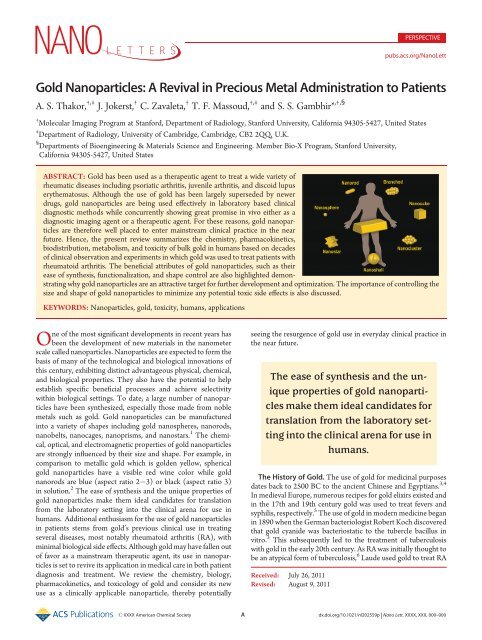
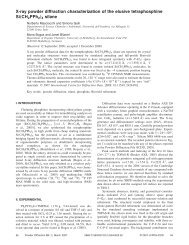
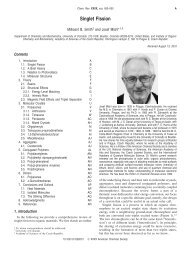
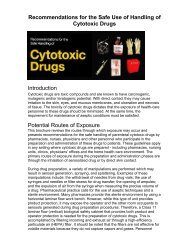
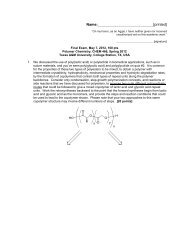

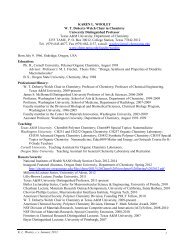
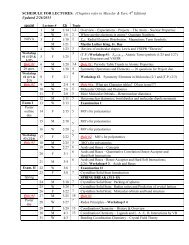
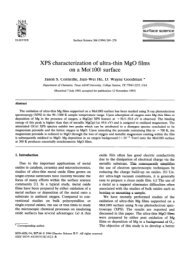
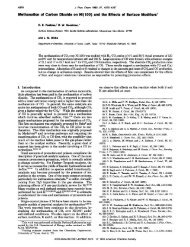
![Radical salts of TTF derivatives with the metal–metal bonded [Re2Cl8]](https://img.yumpu.com/10115211/1/190x253/radical-salts-of-ttf-derivatives-with-the-metal-metal-bonded-re2cl8.jpg?quality=85)


